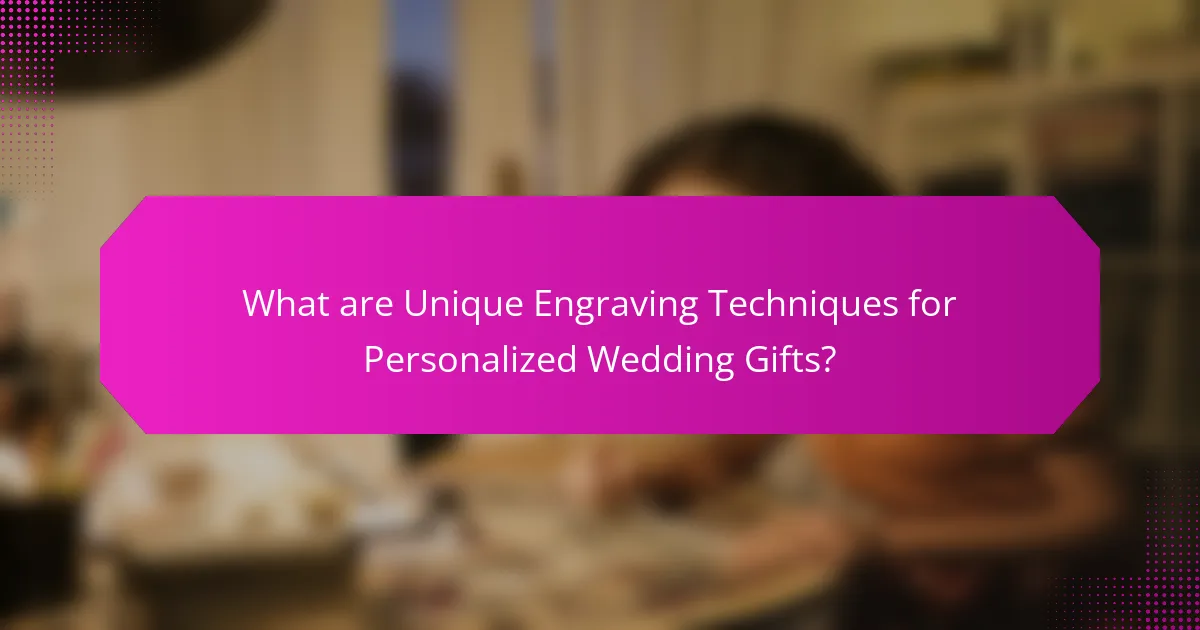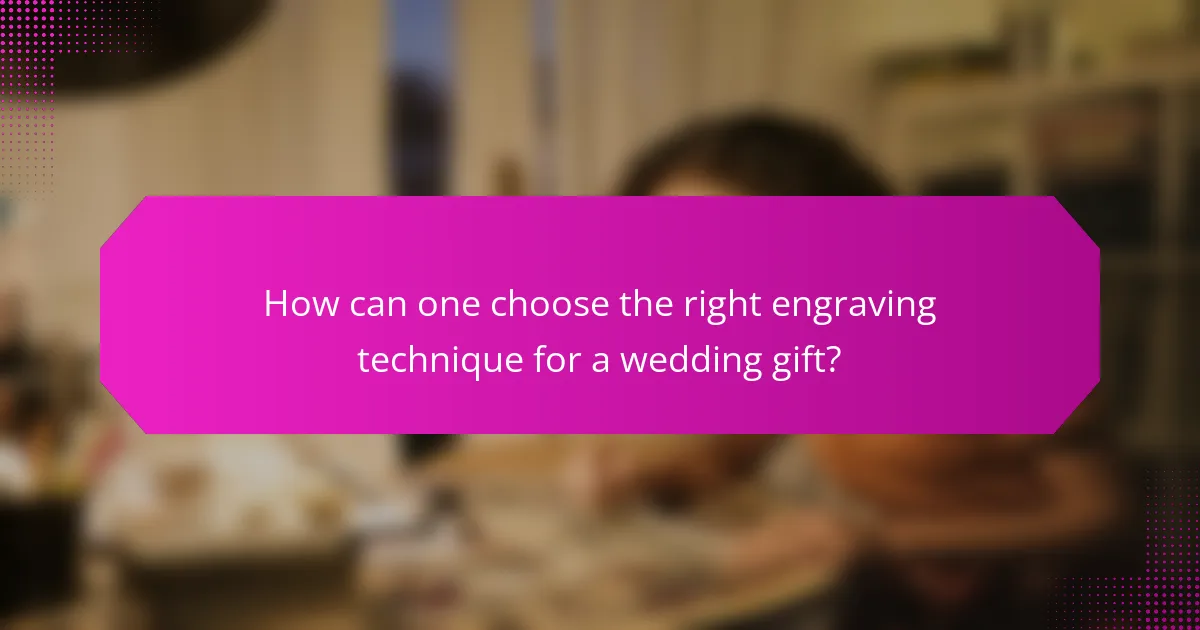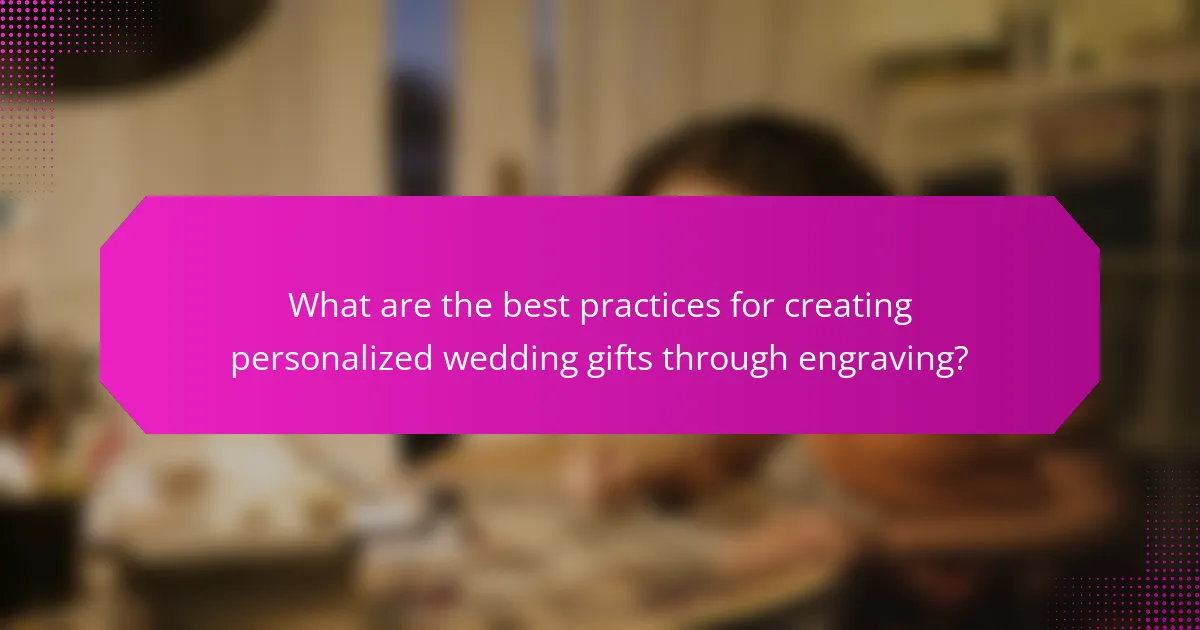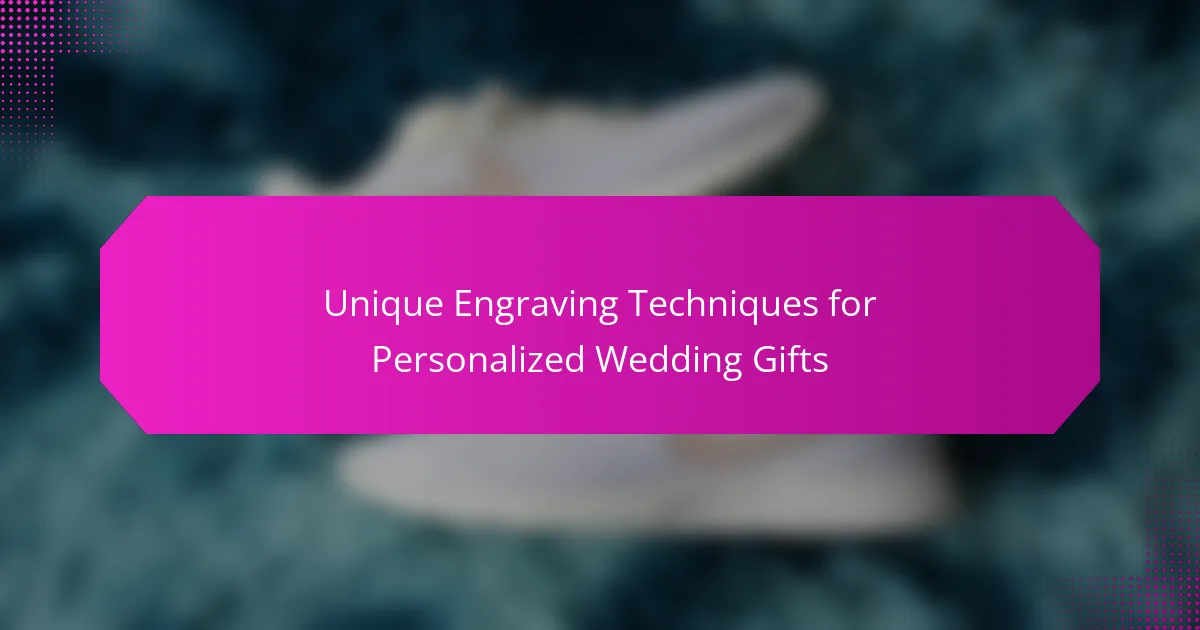Unique engraving techniques, including laser engraving, hand engraving, and rotary engraving, offer personalized options for wedding gifts. Laser engraving provides intricate detail on materials like wood and glass, while hand engraving adds a personal touch through skilled craftsmanship. Rotary engraving is suitable for metals and creates durable designs. Selecting the appropriate engraving technique depends on the material, design complexity, and recipient preferences. Best practices for creating personalized gifts involve choosing suitable materials, meaningful text, and ensuring high-quality engraving for a memorable outcome.

What are Unique Engraving Techniques for Personalized Wedding Gifts?
Unique engraving techniques for personalized wedding gifts include laser engraving, hand engraving, and rotary engraving. Laser engraving uses high-powered lasers to etch designs into various materials. This method allows for intricate detail and precision. Hand engraving involves skilled artisans using tools to carve designs manually. This technique offers a personal touch and unique craftsmanship. Rotary engraving utilizes a rotating cutting tool to create designs. It is suitable for a variety of surfaces and materials. Each technique can create lasting impressions on wedding gifts, enhancing their sentimental value.
How do these engraving techniques enhance the personalization of wedding gifts?
Engraving techniques enhance the personalization of wedding gifts by allowing for custom messages and designs. These techniques enable couples to add names, dates, or meaningful quotes. Personalization creates a deeper emotional connection to the gift. Engraved items often become cherished keepsakes. They reflect the couple’s unique story and shared experiences. Techniques like laser engraving provide precision and detail. This ensures high-quality, lasting impressions on various materials. Customization through engraving transforms ordinary gifts into memorable treasures.
What types of materials can be used for engraving in wedding gifts?
Common materials for engraving in wedding gifts include wood, metal, glass, and acrylic. Wood is often used for personalized items like cutting boards and photo frames. Metal, such as stainless steel or aluminum, is popular for jewelry and decorative pieces. Glass offers a sleek surface for engraving on items like vases or picture frames. Acrylic is lightweight and can be shaped into various designs, making it suitable for awards or decorative items. These materials are favored due to their durability and aesthetic appeal.
How does the choice of material influence the engraving technique?
The choice of material significantly influences the engraving technique used. Different materials, such as wood, glass, and metal, require distinct approaches. For instance, wood engraving often utilizes rotary tools to achieve depth and texture. Glass engraving typically employs sandblasting or laser engraving for precision and clarity. Metal engraving may involve techniques like etching or laser cutting, which require specific equipment and settings. Each material’s hardness and texture dictate the engraving method to ensure quality results. For example, softer materials allow for deeper cuts, while harder materials necessitate finer, more precise techniques.
Why are personalized wedding gifts important for couples?
Personalized wedding gifts are important for couples because they symbolize thoughtfulness and intimacy. These gifts reflect the couple’s unique relationship and shared experiences. Personalization adds emotional value, making the gift more memorable. Studies show that personalized gifts are often cherished longer than generic ones. According to a survey by the Gift Association, 70% of recipients feel more connected to the giver when receiving personalized items. This emotional connection enhances the significance of the gift. Additionally, personalized gifts can commemorate special moments, such as wedding dates or shared interests. This creates lasting memories that couples can cherish throughout their lives.
What emotional value do personalized gifts hold for newlyweds?
Personalized gifts hold significant emotional value for newlyweds. These gifts symbolize thoughtfulness and effort in the relationship. They often commemorate shared experiences and milestones. Personalized items can evoke cherished memories, enhancing emotional connections. Such gifts reflect the couple’s unique bond and individuality. According to a study by the Journal of Social and Personal Relationships, personalized gifts strengthen relationship satisfaction. This emotional resonance reinforces the couple’s commitment to each other. Overall, personalized gifts serve as lasting reminders of love and partnership.
How do personalized gifts reflect the couple’s unique story?
Personalized gifts reflect a couple’s unique story by incorporating elements that are significant to their relationship. These gifts often feature names, dates, or special messages that commemorate shared experiences. For example, a custom engraved photo frame may highlight a memorable moment, such as an engagement or wedding day. This personal touch transforms a standard item into a cherished keepsake. Furthermore, the choice of gift itself can symbolize aspects of their journey together, such as a shared hobby or interest. Research indicates that personalized gifts enhance emotional connection, making them more meaningful. This emotional resonance reinforces the couple’s bond and celebrates their individuality as a pair.
What are the different styles of engraving techniques available?
The different styles of engraving techniques available include laser engraving, rotary engraving, and hand engraving.
Laser engraving uses a focused laser beam to etch designs onto surfaces. This technique allows for high precision and intricate details. Rotary engraving involves a rotating cutting tool that carves into the material. It is often used for deeper cuts and more textured designs. Hand engraving is a traditional method where artisans use manual tools to create designs. This style offers a personal touch and unique craftsmanship.
Each engraving technique has its own applications and advantages. Laser engraving is popular for its speed and accuracy. Rotary engraving is favored for its ability to create depth. Hand engraving is cherished for its artistry and individuality.
What is the difference between laser engraving and hand engraving?
Laser engraving uses a laser beam to etch designs onto surfaces. Hand engraving involves manually carving designs with tools. The precision of laser engraving allows for intricate details and uniformity. In contrast, hand engraving offers a unique, artisanal touch. Laser engraving is faster and can be automated. Hand engraving is time-consuming and requires skilled artisans. Laser engraving works on various materials, including wood, metal, and glass. Hand engraving is often limited to softer materials like metal and wood.
How do different engraving styles affect the overall aesthetic of the gift?
Different engraving styles significantly influence the overall aesthetic of a gift. Each style brings a unique texture and visual appeal. For instance, cursive engraving offers elegance and a personal touch. Block engraving, on the other hand, provides a modern and bold look.
Intricate designs can enhance the artistic value of the gift. Simple engravings may convey minimalism and sophistication. The choice of font also impacts readability and style perception. Additionally, the depth and technique of engraving can create varying levels of shine and shadow.
These factors collectively determine the gift’s emotional resonance and presentation. Engraving styles can reflect the recipient’s personality or the occasion’s significance. Thus, selecting the right engraving style is essential for enhancing the gift’s aesthetic.

How can one choose the right engraving technique for a wedding gift?
To choose the right engraving technique for a wedding gift, consider the material of the item. Different materials require specific engraving methods. For instance, laser engraving works well on wood and glass, providing precision and detail. Conversely, rotary engraving is suitable for metals, offering durability and a classic finish.
Next, evaluate the design complexity. Intricate designs benefit from laser techniques, while simpler designs can be effectively executed with hand engraving. Additionally, think about the size of the item. Smaller items may require finer techniques, while larger surfaces can accommodate bolder engravings.
Finally, consider the recipient’s preferences. Personalized touches resonate more when they align with the couple’s style. Research shows that thoughtful personalization enhances the emotional value of gifts, making them more memorable.
What factors should be considered when selecting an engraving technique?
When selecting an engraving technique, consider the material being engraved. Different materials require specific techniques for optimal results. For example, metal often uses laser engraving, while wood may utilize rotary engraving.
Next, assess the complexity of the design. Intricate designs may necessitate a technique that allows for fine detail, such as laser engraving. Simpler designs can be effectively rendered using methods like sandblasting.
Another factor is the intended use of the engraved item. Items exposed to wear and tear may benefit from more durable techniques like deep engraving. Conversely, decorative items may prioritize aesthetic appeal over durability.
Cost is also a critical factor. Some techniques, like hand engraving, can be labor-intensive and expensive. Budget constraints may lead to the selection of more cost-effective methods such as machine engraving.
Finally, the desired finish should be considered. Different techniques produce varying textures and appearances. For instance, laser engraving results in a clean, precise finish, while hand engraving can offer a more personalized touch.
How does the gift’s design influence the choice of engraving?
The gift’s design significantly influences the choice of engraving by determining the available space and style for personalization. A minimalist design may require simpler, more concise engravings. In contrast, intricate designs can accommodate detailed messages or elaborate patterns. The material of the gift also impacts engraving choices; for example, wood allows for deeper carving, while glass may require surface etching. Additionally, the overall aesthetic of the gift guides the font and layout of the engraving. For instance, a romantic gift design may favor elegant script fonts, while a modern design might use bold, sans-serif fonts. This alignment between design and engraving enhances the overall visual appeal and personal significance of the gift.
What role does the recipient’s preference play in selecting an engraving technique?
The recipient’s preference is crucial in selecting an engraving technique. Their taste influences the choice of style, depth, and material. For instance, some recipients may prefer intricate designs, while others favor minimalistic approaches. Additionally, the recipient’s personality can dictate whether a playful or formal engraving is appropriate. Preferences also extend to the type of font and layout used in the engraving. Choosing a technique that aligns with the recipient’s aesthetic ensures the gift is meaningful. Ultimately, honoring the recipient’s preference enhances the personalization of the wedding gift.
What are some common mistakes to avoid when engraving wedding gifts?
Common mistakes to avoid when engraving wedding gifts include choosing the wrong font. A complex or overly decorative font can be hard to read. Additionally, failing to double-check spelling can lead to embarrassing errors. Not considering the size of the engraving is another mistake; it should fit well within the design. Ignoring the material’s properties can also affect the quality of the engraving. For example, some materials may not hold detail well. Lastly, not allowing enough time for the engraving process can lead to rushed work and lower quality. Each of these mistakes can diminish the sentimental value of the gift.
How can one ensure the accuracy of names and dates in engravings?
To ensure the accuracy of names and dates in engravings, it is essential to double-check all information before engraving. This includes verifying spelling, punctuation, and numerical accuracy. Utilizing templates or proofs can help visualize the final product. Engravers should also confirm details with clients to avoid misunderstandings. Using high-quality engraving tools can reduce errors during the engraving process. Lastly, reviewing the engraving after completion can catch any mistakes before the item is finalized. This methodical approach minimizes the risk of inaccuracies in personalized engravings.
What should be done to maintain the quality of the engraving over time?
To maintain the quality of the engraving over time, regular cleaning is essential. Use a soft, lint-free cloth to gently wipe the engraved surface. Avoid abrasive materials that can scratch the engraving. Additionally, store the engraved items in a dry, cool place to prevent moisture damage. Applying a protective coating can also help preserve the clarity of the engraving. Engravings made on metals are particularly susceptible to tarnishing; thus, using a metal polish can enhance their durability. Regular maintenance can extend the life of the engraving significantly.

What are the best practices for creating personalized wedding gifts through engraving?
The best practices for creating personalized wedding gifts through engraving include selecting the right material, choosing meaningful text, and ensuring high-quality engraving. Start by selecting materials that are suitable for engraving, such as wood, glass, or metal. Each material has unique properties that affect the engraving process and final appearance. Next, choose text that holds significance for the couple, such as their names, wedding date, or a special quote. This adds a personal touch to the gift.
Ensure the font style is legible and complements the overall design of the gift. Simple, classic fonts often work best for readability. Additionally, consider the size and placement of the engraving to enhance visibility and aesthetics. Using a professional engraving service can guarantee precision and quality, as they have the right tools and expertise.
Finally, test the engraving on a sample piece if possible. This allows for adjustments before committing to the final product. Following these practices will result in a thoughtful and memorable personalized wedding gift.
How can one effectively plan for a personalized engraving project?
To effectively plan for a personalized engraving project, start by defining the purpose of the engraving. Identify the occasion, such as a wedding or anniversary. Next, choose the material for the item to be engraved, like wood, metal, or glass. Consider the design elements, including text and imagery, that will convey the intended message. Research engraving techniques suitable for the chosen material, such as laser or hand engraving. Set a budget to cover materials and potential professional engraving services. Finally, allow ample time for the project, factoring in design approval and production time. Following these steps ensures a thoughtful and personalized engraving project.
What steps should be taken to gather ideas for the engraving design?
Identify the purpose of the engraving design. Consider the occasion, recipient, and message. Research popular engraving styles and themes. Explore online galleries for inspiration. Gather materials that reflect the couple’s interests. Sketch initial ideas based on gathered inspirations. Consult with the recipient for personal touches. Finalize the design by combining elements into a cohesive layout.
How can one collaborate with engravers to achieve the desired outcome?
To collaborate with engravers effectively, one should communicate clear design ideas. Provide sketches or examples of the desired engraving style. Discuss specific materials and dimensions for the item to be engraved. Set a timeline for completion to ensure the project stays on track. Provide feedback during the process to refine the design as needed. Establish a budget to align expectations on costs. Engravers often rely on precise details to achieve the best results. Clear collaboration enhances the final outcome, ensuring it meets personal or gifting standards.
What tips can help ensure a successful engraving experience?
To ensure a successful engraving experience, choose the right material for engraving. Different materials react differently to engraving techniques. For example, metals like stainless steel provide durability. Select a design that fits the item’s surface area. This helps in achieving clarity and precision. Test the engraving settings on a scrap piece first. This allows for adjustments before the final engraving. Clean the surface before engraving to remove any dust or oils. A clean surface ensures better adhesion and clarity. Lastly, take your time during the engraving process. Rushing can lead to mistakes and affect the final outcome.
How can one choose the right engraver for their wedding gift project?
To choose the right engraver for a wedding gift project, assess their portfolio for quality and style. Look for engravers who specialize in wedding gifts or similar items. Check customer reviews and testimonials for reliability and craftsmanship. Inquire about their techniques and materials used to ensure they meet your expectations. Discuss your specific design ideas and see how they can accommodate them. Confirm their turnaround time to ensure it aligns with your project deadline. Finally, compare pricing to ensure it fits within your budget while still maintaining quality.
What are the best ways to communicate engraving ideas to the engraver?
The best ways to communicate engraving ideas to the engraver include providing clear visual references. Use sketches or images to illustrate your concepts. Descriptive language is also essential; specify fonts, sizes, and styles desired. Discuss the material and size of the item being engraved to ensure compatibility. Share examples of previous work to convey your vision effectively. Additionally, maintain open communication; ask for feedback to refine ideas. This collaborative approach enhances understanding and results in a more satisfactory outcome.
Unique engraving techniques for personalized wedding gifts encompass methods such as laser engraving, hand engraving, and rotary engraving, each offering distinct advantages in terms of precision and craftsmanship. The article explores how these techniques enhance personalization through custom messages and designs, adding emotional value to gifts. It also discusses suitable materials for engraving, the impact of design choices on engraving techniques, and the importance of considering recipient preferences. Additionally, best practices for planning and executing engraving projects are provided to ensure successful outcomes.
